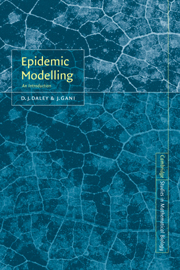Preface
Published online by Cambridge University Press: 16 November 2009
Summary
This monograph is designed to introduce probabilists and statisticians to the diverse models describing the spread of epidemics and rumours in a population. Not all epidemic type processes have been included. With minor exceptions, we have restricted ourselves to the spread of viral and bacterial infections, or to the propagation of rumours, by direct contact between infective and susceptible individuals. Host–vector and parasitic infections have been mentioned only very briefly.
Throughout the book, the emphasis is on the mathematical modelling of epidemics and rumours, and the evolution of this modelling over the past three centuries.
Chapter 1 is a historical introduction to the subject, with illustrations of the most common approaches to modelling. This is followed in Chapter 2 by an account of deterministic models, in both discrete and continuous time. Chapter 3 analyses stochastic models in continuous time, and includes detailed studies of the simple, general and carrier-borne epidemics. In Chapter 4, the main stochastic models in discrete time, namely the chain binomial models are studied, and a pairs-at-parties and related models outlined. Chapter 5 considers models for the propagation and cessation of rumours, and exploits some of the techniques introduced earlier to analyse them; the results highlight differences between these and the classical epidemic models. Chapter 6, which is essentially statistical, is concerned with the fit of various models to observed epidemic data. The book ends with Chapter 7, which describes three main methods of controlling epidemics. A list of references that also incorporates an author index, and a subject index are provided at the end.
- Type
- Chapter
- Information
- Epidemic ModellingAn Introduction, pp. xi - xiiPublisher: Cambridge University PressPrint publication year: 1999
- 1
- Cited by

